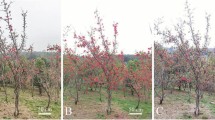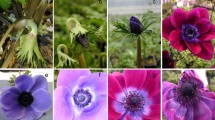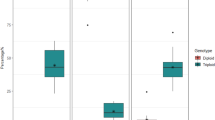Abstract
Pollen viability and stigma receptivity are prerequisites for successful pollination and seed set in flowering plants. In this study, the pollen viabilities and stigma receptivities of nine Lilium genotypes (six cultivars and three species native to China) were assayed by in vitro pollen germination and the benzidine-H2O2 method, respectively. Embryo sac development during anthesis was observed to further ensure the timing of controlled pollination. In addition, the relationship between stigma secretion and stigma receptivity was studied to estimate the pollination time based on phenotype. Anthers cracked on the day of flowering in all genotypes, but pollen germination during anthesis was not observed in Asiatic hybrids excepted for ‘Tiny pudhye’, which exhibited low pollen viability for a short period of time (from 0 to 1 day after anthesis). In the other genotypes, pollen germination rates were highest on anthesis (five of seven genotypes), 0–1 day after anthesis (L. sulphureum), or 0–2 days after anthesis (one Longiflorum hybrid), and then gradually decreased with days after anthesis. While, stigma receptivity first increased and then decreased during anthesis. For most genotypes, stigmas began to be receptive 1 day after anthesis, and all genotypes exhibited stigma receptivity at 2 days after anthesis. The durations of stigma receptivity and strongest stigma receptivity, were genotype dependent, and were 5–8 days and 1–4 days, respectively. Moreover, on the first flowering day, 6 of 7 genotypes had mature embryo sacs, and at the time at which stigmas began to be receptive, all tested genotypes had mature embryo sacs. Some Lilium genotypes showed stigma secretion, which can be a sign of stigma receptivity. Stigmas became receptive and reached highest receptivity within 1 day of the first appearance of secretion on the surface of the stigma and at peaking, respectively. The results of this study are valuable for the implementation of successful Lilium breeding programs.


Similar content being viewed by others
References
Amaki W, Yamamoto Y (1988) Pollen tube growth in the pistils grafted with style of different cultivar or with cross or self pre-pollinated styles of Lilium longiflorum. J Jpn Soc Hortic Sci 57(2):269–272
Amaki W, Tezuka T, Yamamoto Y (1989) Effect of pistillary sap on the in vivo pollen tube growth and changes in components of stylar sap by pollination in Lilim longiflorum thumb. J Jpn Soc Hortic Sci 75(4):648–654
Asano Y (1978) Studies on crosses between distantly related species of lilies. III. New hybrids obtained through embryo culture. J Jpn Soc Hortic Sci 47(3):401–414
Asano Y (1982) Chromosome association and pollen fertility in some interspecific hybrids of Lilum. Euphytica 31:121–128
Asano Y (1983) Random distribution of the number of chromosome pairings in interspecific hybrids of Llilum. Cytologia 48:803–809
Asano Y, Myodo H (1977) Studies on crosses between distantly related species of lilies. I. For the intrastylar pollination technique. J Jpn Soc Hortic Sci 46(1):59–65
Ascher PD (1975) Special stylar property required for compatible pollen-tube growth in Lilium longiflorum Thunb. Int J Plant Sci 136(3):317–321
Ascher PD, Peloquin SJ (1966) Effect of floral aging on the growth of compatible and incompatible pollen tubes in Lilium longiflorum. Am J Bot 53(1):99–102
Ascher PD, Peloquin SJ (1968) Pollen tube growth and incompatibility following intra- and interspecific pollinations in Lilium longiflorum. Am J Bot 55(10):1230–1234
Barba-Gonzalez R (2005) The use of 2n gametes for introgression breeding in Oriental × Asiatic lilies. PhD-thesis, University Wageningen
Barba-Gonzalez R, Ramanna MS, Visser RGF, Van Tuyl JM (2005) Intergenomic recombination in F1 lily hybrids (Lilium) and its significance for genetic variation in the BC1 progenies as revealed by GISH and FISH. Genome 48:884–894
Baskorowati L (2009) Stigma receptivity and pollen viability of Melaleuca alternifolia. J For Res Jpn 6(1):26–36
Bennett MD, Leitch IJ (2012) Plant DNA C-values database (release 6.0, December 2012). http://data.kew.org/cvalues/
Bhattacharya A (2011) Does canopy height determine the pollen viability and stigma receptivity? A cross-population observation on Shorea robusta Gaertn. f. Our Nat 9:41–48
Bhattacharya A, Mandal S (2004) Pollination, pollen germination and stigma receptivity in Moringa oleifera Lamk. Grana 43(1):48–56
Comber HF (1949) A new classification of the Lilium. Lily Yearb R Hortic Soc 13:86–105
Dafni A (1992) Pollination ecology: a practical approach. Oxford University Press, Oxford
Dafni A, Firmage D (2000) Pollen viability and longevity: practical, ecological and evolutionary implications. Plant Syst Evol 222:113–132
Dafni A, Maués MM (1998) A rapid and simple procedure to determine stigma receptivity. Sex Plant Reprod 11:177–180
Griffin AR, Ching KK, Johnson KW, Hand FC, Burgess IP (1982) Processing Eucalyptus pollen for use in controlled pollination. Silvae Genet 31:198–203
Heslop-Harrison Y, Shivanna KR (1977) The receptive surface of the angiosperms stigma. Ann Bot 41:1233–1258
Heslop-Harrison J, Heslop-Harrison Y, Shivanna KR (1984) The evaluation of pollen quality and a further appraisal of the fluorochromatic (FCR) test procedure. Theor Appl Genet 67:367–375
Hu SY (2005) Reproductive biology of angiosperm. Higher Education Press, Beijing
Janson J (1992) Pollen tube - pistil interaction and fertilization in Lilium Iongiflorum. PhD-thesis, University Wageningen
Janson J, Willemse MTM (1995) Pollen tube penetration and fertilization in Lilium longiflorum (Liliaceae). Am J Bot 82(2):186–196
Janson J, Reinders MC, van Tuyl JM, Keijzer CJ (1993) Pollen tube growth in Lilium longiflorum following different pollination techniques and flower manipulations. Acta Bot Neerl 42(4):461–472
Janson J, Reinders MC, Valkering AGM, van Tuyl JM, Keijzer CJ (1994) Pistil exudate production and pollen tube growth in Lilium longiflorum Thunb. Ann Bot 73:437–446
Kalinganire A, Harwood CE, Slee MU, Simons AJ (2000) Floral structure, stigma receptivity and pollen viability in relation to protandry and self-incompatibility in silky oak (Grevillea robusta A. Cunn). Ann Bot 86:133–148
Kearns CA, Inouye DW (1993) Techniques for pollination biologists. Colorado University Press, Colorado, p 583
Khan MN (2009) A molecular cytogenetic study of intergenomic recombination and introgression of chromosomal segments in lilies (Lilium). PhD-thesis, University Wageningen
Khan MN, Zhou S, Ramanna MS, Arens P, Herrera J, Visser RGF, Van Tuyl JM (2009) Relevance of diploid BC progenies for intergenomic recombination and introgression breeding in Longiflorum × Asiatic hybrids of lilies (Lilium L.). Euphytica 166:399–406
Li J, Yuan S, Liu C, Tian M, Yu N (2012) Actors affecting viability and development of isolated microspore in Lilium. North Hortic 03:59–63
Liang SY, Tamura M (2000) Lilium. In: Wu ZY, Raven PH (eds) Flora of China, vol 24. Science Press, Beijing, pp 118–152
Lim TK (2014) Lilium lancifolium. In: Lim TK (ed) Edible medicinal and non medicinal plants, vol 8. Flowers. Springer, Dordrecht, pp 215–220
Liu Y (2015) Lilium lancifolium (Baihe, Tiger Lily). In: Liu Y, Wang ZM, Zhang J (eds) Dietary Chinese herbs. Springer, Vienna, pp 147–148
Maheshwari P (1950) An introduction to the embryology of angiosperms. McGraw-Hill, London, pp 84–152
McRae EA (1998) Lilies: a guide for growers and collectors. Timber Press, Portland
Noda S (1986) Cytogenetic behavior, chromosomal differentiations, and geographic distribution in Lilium lancifolium (Liliaceae). Plant Species Biol 1:69–78
Prosevičius J, Strikulyte L (2004) Interspecific hybridization and embryo rescue in breeding of lilies. Acta Universitatis Latviensis Biology 676:213–217
Razora OP, Zsuffa L (1986) Pollen viability of some Populus species as indicated by in vitro pollen germination and tetrazolium chloride staining. Can J Bot 64:1086–1088
Rodriguez RT, Dafni A (2000) A new procedure to asses pollen viability. Sex Plant Reprod 12:241–244
Sanzol J, Herrero M (2001) Review: the effective pollination period in fruit trees. Sci Hortic 90:1–17
Sedgley M, Smith RM (1989) Pistil receptivity and pollen tube growth in relation to the breeding system of Eucalyptus woodwardii (Symphyomyrtus: Myrtaceae). Ann Bot 64:21–31
Shivanna KR (2003) Pollen biology and technology. Science Publishers, Enfield
Shivanna KR, Johri BM (1985) The angiosperm pollen: structure and function. Wiley Eastern Ltd., New Delhi
Sliva LAC, Pagliarini MS, Santos SA, Valle CB (2013) Stigma receptivity, mode of reproduction, and mating system in Mesosetum chaseae Luces (Poaceae), a native grass of the Brazilian Pantanal. Genet Mol Res 12(4):5038–5045
Souza EH, Carmello-Guerreiro SM, Souza FVD, Rossi ML, Martinelli AP (2016) Stigma structure and receptivity in Bromeliaceae. Sci Hortic 203:118–125
Van Creij MGM, van Raamsdonk LWD, Van Tuyl JM (1990) Wide interspecific hybridization of Lilium: preliminary results of the application of pollination and embryo-rescue methods. Lily Yearb North Am Lily Soc 43:28–37
Van Tuyl JM, Marcucci MC, Visser T (1982) Pollen and pollination experiments. VII. The effect of pollen treatment and application method on incompatibility and incongruity in Lilium. Euphytica 31:613–619
Van Tuyl JM, Van Diën MP, Van Creij MGM, Van Kleinwee TCM, Franken J, Bino RJ (1991) Application of in vitro pollination, ovary culture, ovule culture and embryo rescue for overcoming incongruity barriers in interspecific Lilium crosses. Plant Sci 74:115–126
Van Tuyl JM, Arens P, Ramanna MS, Shahin A, Khan N, Xie S, Marasek-Ciolakowska A, Lim KB, Barba-Gonzalez R (2011) Lilium. In: Kole C (ed) Wild crop relatives: genomic and breeding resources, plantation and ornamental crops. Springer, Berlin, pp 161–183
Willemse MTM, Plyushch TA, Reinders MC (1995) In vitro micropylar penetration of the pollen tube in the ovule of Gasteria verrucosa (Mill.) H. Duval and Lilium longiflorum Thunb.: conditions, attraction and application. Plant Sci 108:201–208
Woodcock HBD, Stearn WT (1950) Lilies of the world: their cultivation & classification. Country Life, London
Xie S (2012) A molecular cytogenetic analysis of chromosome behavior in Lilium hybrids. PhD-thesis, University Wageningen
Yuan S, Liu C, Ming J (2016) A new lily cultivar ‘Jinghe’. Acta Hortic Sin 43(9):1845–1846
Zhou S (2007) Intergenomic recombination and introgression breeding in Longiflorum × Asiatic lilies, PhD-thesis, University Wageningen
Zhou S, Ramanna MS, Visser RGF, Van Tuyl JM (2008) Genome composition of triploid lily cultivars derived from sexual polyploidization of Longiflorum × Asiatic hybrids (Lilium). Euphytica 160:207–215
Zhou S, Li K, Zhou G (2012) Analysis of endosperm development of allotriploid × diploid/tetraploid crosses in Lilium. Euphytica 184:401–412
Zhou S, Yuan G, Xu P, Gong H (2014) Study on lily introgression breeding using allotriploids as maternal parents in interploid hybridizations. Breed Sci 64:97–102
Acknowledgements
This work was supported by the National Natural Science Foundation of China (31301804), the Special Fund for Agro-scientific Research in the Public Interest (201203071), the Chinese National Key Technology R&D Program (2012BAD01B0701), the National Center for Flower Improvement, and the Key Laboratory of Biology and Genetic Improvement of Horticultural Crops, Ministry of Agriculture, P. R. China. We also acknowledge partial funding from the Science and Technology Innovation Program of the Chinese Academy of Agricultural Sciences (CAAS-ASTIP-2016-IVFCAAS).
Author information
Authors and Affiliations
Corresponding author
Additional information
Guoren He and Fengrong Hu have contributed equally to this work.
Rights and permissions
About this article
Cite this article
He, G., Hu, F., Ming, J. et al. Pollen viability and stigma receptivity in Lilium during anthesis. Euphytica 213, 231 (2017). https://doi.org/10.1007/s10681-017-2019-9
Received:
Accepted:
Published:
DOI: https://doi.org/10.1007/s10681-017-2019-9




